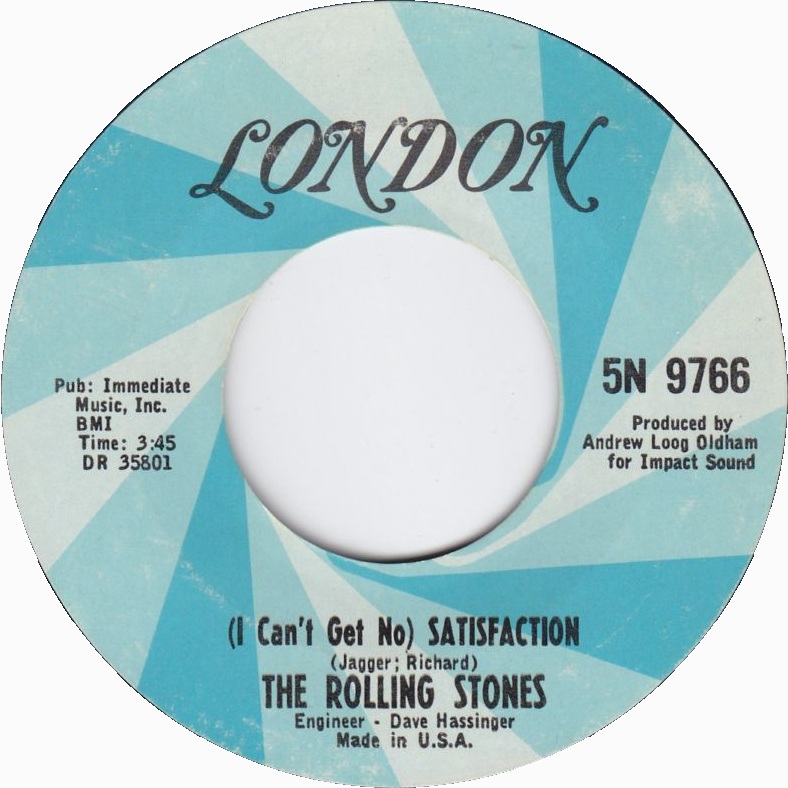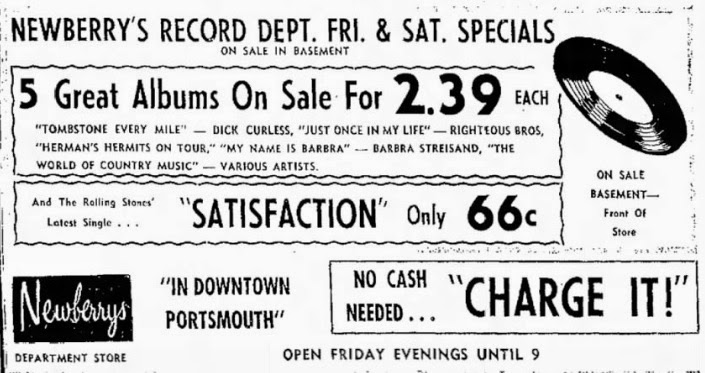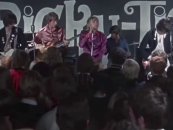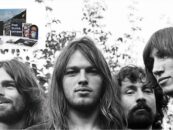 Can later generations even comprehend what it felt like for those growing up back then as the summer of 1965 was in full bloom and The Rolling Stones truly arrived in America by scoring their first chart-topper with “(I Can’t Get No) Satisfaction” on July 10, 1965.
Can later generations even comprehend what it felt like for those growing up back then as the summer of 1965 was in full bloom and The Rolling Stones truly arrived in America by scoring their first chart-topper with “(I Can’t Get No) Satisfaction” on July 10, 1965.
If you were at all interested in popular music there was one place we all went to hear the latest songs: Top 40 AM radio.
You generally bought your music at one of the few national chain stores like Woolworth’s or a hi-fi shop. The 45 RPM single was the common musical currency; albums were a luxury item. You generally listened to it on a transistor radio – a fairly recent technological innovation. Or the car radio that also made recorded music portable. Or maybe, usually if the old folks were out, the high-fidelity record-player and radio consoles that were a substantial piece of furniture in the living room. Really loud.
The Beatles had arrived a year-and-a-half earlier to sweep away the national shock and malaise that followed the shooting of President John F. Kennedy. And reinvigorate the aura of youthfulness and a luminous future he’d infused into the popular consciousness – four shiny, happy guys in matching suits playing and singing music so rich with verve and luster it was irresistible.
Then came the Fab Four’s flipside: The Stones with their mismatched outfits, long hair a bit more mussy, their blues music roots conveying a sizzling frisson of danger.
At first listen it was an epiphany, a bolt of lightning that not just illuminated the landscape but in one unrestrained blast of energy changed it forever. Two cracking Keith Richards electric guitar E-notes through his newly acquired Maestro Fuzztone FZ-1. Then in strides Bill Wyman’s bass counterpoints to the song’s riff that came to Keef in a dream. Six beats later Charlie Watts snaps in with a drum beat that trots and swings its hips in a beat you just wanna dance to. A faint slashing acoustic rhythm guitar starts to sneak in….
Then Mick Jagger coos in a slightly fey if not androgynous voice: “I can’t get no… satisfaction.” If you were one of the millions of guys and girls anywhere within hailing distance of puberty, you knew exactly what he was singing about.
Three simple chords, E-D-A, with a B7 accent each time ’round, yet the band swoops, darts and swirls to draw out all their melodic possibilities in just shy of four minutes. Jagger struts through a spectrum of impassioned emotions. It was, in a word with two ante-upping modifiers, utterly and completely perfect. Right on time, thoroughly of its time, and so right for the time. Hey, hey, hey!
Related: The Rolling Stones in Mono; Interview with ABKCO Records’ chief audio engineer
For its four weeks to follow atop the Billboard Top 100 and beyond, “Satisfaction” was everywhere, bigger than the most viral meme, literally in the atmosphere via radio waves and in the air though many millions of magnetic coned speakers.
Fourteen years later the landscape had shifted and changed time and again. Yet on August 15, 1979, the opening day of Apocalypse Now, in the scene in which the PBR Streetgang surfs up the river, once again, “Satisfaction” was perfect. Getting the kid dancing. Uniting black and white in delight. as it did when it coincided with the first anniversary of President Johnson signing the Civil Rights on July 2, 1964. And it still carried whiffs of foreboding and the dangers that lay waiting further up the river.
At some point today do yourself a favor and just take three minutes and forty-three seconds out of your day. If you were born just about anytime after 1960, try to insert yourself into the atmosphere of season four of “Mad Men”… and really listen to “Satisfaction.”
As I contend that music is qualitative not quantitative, I shy away from saying it’s the greatest rock ‘n’ roll song ever; way too many others vie for that title. But whenever it plays, hell yeah it’s The Greatest. Just like the other Greatest of that time: Muhammad Ali neé Cassius Clay – who had TKO’d Sonny Liston in their second bout in the first round to retain his belt as Heavyweight Champion of the World some two months before “Satisfaction” topped the chart – dancing like a butterfly and stinging like a bee in the ring in his prime, young, beautiful, poetic yet primal, rebellious, alluring, graceful yet menacing.
Six decades later, it remains a paragon of perfection, as classic as a rock song can be, and not just timeless but beyond that to sound even better than ever a half century after it ruled the airwaves – the Heavyweight Champion Rock Music Single of The World, again, whenever it plays. Hey, hey, hey, that’s what I say.
When the Stones tour, tickets are available here and here.
- I Get a Check From John Lennon - 12/08/2025
- B.B. King May Be Gone But the Thrill Remains - 09/16/2025
- Bobby Whitlock Interview on Derek & the Dominos - 08/11/2025







8 Comments so far
Jump into a conversationThe last time I heard the song(a few weeks back), I was walking thru my local Walmart on a Saturday morning and it was playing on the overhead system. Still the greatest ever made. “He can’t be a man, ’cause he doesn’t smoke the same cigarettes as me…”. Nothing else to say…
That summer I would play it on the old Magnavox on repeat 7or 8 times a day.
With Satisfaction suddenly everyone was listening to the Stones. That took away some of the excitement for me. I’m much more likely to turn up the volume on The Last Time when it comes on.
I was just about twenty years and Satisfaction came !!
A few weeks later came “Like a rolling stone”.
Can you imagine this summer ??
Remember one of my school mates brought the single to school one day – grade 10 I think – and promptly got sent to detention!
Had to get home and listen to Radio Luxembourg instead – the only source we had in Switzerland back then to be up-to-date on that “new” music!
Perhaps one of the strangest little known musical aspects concerning the making of the social phenomenon of “Satsifaction,” was that in Keith Richards’ mind, his iconic fuzz-tone riff was laid down on their initial recording, simply as a placeholder for a horn line to be dubbed in later, after they had re-recorded it a second time at RCA studios, having initially recording it in Chicago’s Chess Studios with Brian Jones playing harmonica on that first version just two days earlier. Eventually, Richards’ idea for the horns in lieu of the guitar riff was voted down by the other Stones along with producer Andrew Loog Oldham, when the song was deemed to be used for release as a single, and the rest is history. To my memory, “Satisfaction” may well have been the first radio single to ever utilize the new guitar effect, created by Maestro, which was a subsidiary company of Gibson Guitars and amplifiers. Although it was also used that same year by the studio guitarist on the intro to “Let’s Hang On” by the Four Seasons, but not nearly to the same apparent social notice or musical acclaim. “Satisfaction’s” success not only essentially introduced the soon to be universally used effect to the public’s ears, but it boosted sales of the Gibson Fuzzbox to the extent that the entire available stock of the new unit sold out by the end of 1965.
Thank you so very, very much for what you do, Rob. At the ripe old age of 75, I am pretty much smack dab in the middle of the audience for your incredible postings. I look forward to them so much, and I never fail to find a special treat (or two or three or four or five) in every one of them! You are a real shot in the arm, my friend. KEEP ‘EM COMING!
One of the greatest Rock and Roll songs for sure. It’s still probably my favorite song by the Stones. The Stones created many live versions of this song through the years but nothing beats the 1969 live version with Mick Taylor on guitar.